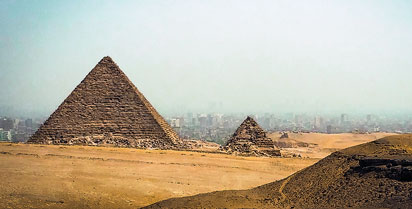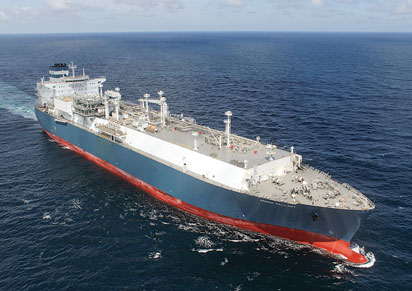Boxscore Construction Analysis
L. Nichols, Editor/Associate Publisher, Hydrocarbon Processing
On the west bank of the Nile River, just on the outskirts of Cairo, sit the Great Pyramids of Giza. Built during the fourth dynasty, the pyramids mark the tombs of the Pharaohs Khufu, Khafre and Menkaure. Their construction marked the height of Egyptian power, economic prosperity and stability. Construction took over 100 years, tens of thousands of laborers and millions of blocks of stone.
Today, the pyramids at Giza are still some of the most magnificent human-made structures ever to be built. The Pyramid of Khufu, the oldest and largest of the three pyramids, is the only wonder of the ancient world still intact.
More than 4,000 years from the time these structures were built, Egypt is embarking on a new, massive construction project—energy infrastructure. Metal and steel have replaced giant stones, and natural gas has become a treasured commodity. This build-out is imperative to feed a growing demand for power generation, alleviate rolling blackouts and mitigate an escalating energy crisis (Fig. 1).
 |
|
Fig. 1. The populous, energy-hungry city of Cairo, Egypt rises up behind the |
Supply and demand. At 77 Tcf, Egypt holds the fourth-largest natural gas reserves in Africa, after Nigeria, Algeria and Mozambique. Domestic natural gas fields are located primarily in the deepwater Mediterranean Sea, the Nile Delta and the Western Desert. Nearly all of Egypt’s natural gas production has been diverted to the domestic market to satisfy surging demand.
Egypt is the largest consumer of oil and natural gas on the continent. The country of over 86 MM people relies on natural gas to generate nearly 70% of power for households and the industrial sector. Increasing consumption and decreasing production has reversed Egypt’s role as an energy exporter to that of an importer.
Due to surging natural gas demand, the country has emerged as a prime destination for both LNG and natural gas pipeline imports. However, the high consumption level has also renewed the country’s outlook on upstream exploration and production (E&P) activities. Imports are vital to Egypt’s power industry in the short term, but new E&P contracts could satisfy consumption and decrease (or even halt) natural gas imports by the end of the decade.
E&P efforts. The start of 2015 marked a new shift in Egypt’s upstream activities. Egypt’s government awarded six of 20 new contracts for oil and gas exploration in the Gulf of Suez and the Western Desert. This new round of exploration awards followed 36 petroleum agreements the Egyptian government has signed with foreign firms since November 2013. These contracts represent an infusion of billions of dollars in new upstream investment, as well as the resurgence of an industry that has seen minimal activity in recent years.
After the 2011 uprising that toppled the Hosni Mubarak regime, natural gas exploration activities nearly ceased due to lack of funds. Foreign firms argued that the Egyptian government was not paying enough for new gas supplies to justify capital-intensive E&P activities.
Coupled with the claims of insufficient reimbursement, new fuel subsidies took a toll on Egypt’s pocketbook. Money destined for oil and gas producers was diverted to pay for fuel subsidies. This led not only to oil companies suspending operations, but it also resulted in the country accumulating $8 B in debt to foreign firms.
With an increasing population accustomed to low-priced gasoline, diesel and electricity, in a country in political turmoil, decreasing fuel subsidies was a political non-starter. Oil and gas developers slowed production and ceased investment in new developments. From 2011–2013, no new exploration contracts were signed. Egypt, the largest non-OPEC oil producer in Africa and the second-largest natural gas producer on the continent, was witnessing a sharp demise of its oil and gas sector.
Fortunes can change quickly, however. In mid-2013, Egyptian Defense Minister Abdel Fattah el-Sisi assumed power through a military coup. Within the next year and a half, the economy began to stabilize, the Gulf Arab countries of Kuwait, Saudi Arabia and the UAE pledged $12 B in aid, new oil and gas exploration contracts were signed, plans were announced to cut fuel subsidies and Egypt began paying off its debt. At the time of this publication, Egypt has reduced its debt from $8 B to $3 B, with the possibility of eliminating its debt by the end of next year.
Also, six new contracts were signed with major oil companies in January. These contracts went to BP, Eni, General Petroleum Co., Shell, Tharwa and Trans Globe. Eni is investing $5 B for oil and gas exploration in the region, which includes the development of 200 MMbbl of oil and 1.3 Tcf of gas over the next four years.
Eni is also partnering with BP on the $12-B Denise-Karawan (DEKA) project. The DEKA project, located in the East Nile Delta, consists of five subsea wells and the installation of subsea production systems, together with subsea pipelines and onshore gas processing facilities at the El Gamil gas plant. BP expects peak production to reach 230 MMcfd.
With all capital-intensive exploration efforts, production takes time. Activity is starting in certain fields, but increasing consumption has outpaced petroleum and liquid fuels production and is quickly gaining on natural gas (Fig. 2).
|
|
|
Fig. 2. Egypt’s oil and natural gas production and consumption. Source: US EIA. |
Egypt has become a new market for natural gas imports over the short term, as demand for the fuel is at an all-time high. Whether it is through LNG or pipelines, imports are a new dynamic in Egypt’s growing energy sector.
LNG, pipelines and FSRUs. Egypt has only two LNG terminals, both designed for export. Total domestic LNG export capacity is 12.7 MMtpy, but actual liquefaction activity is nearly nonexistent. With the decrease in domestic production, the LNG terminals at Damietta and Idku have been starved of gas feedstock. Supplies are so low that the 5.5-MMtpy Damietta LNG terminal has ceased operations. The two-train, 7.2-MMtpy
Idku terminal is still operational, but exporting cargoes have dwindled from 50 in 2013 to only five cargoes in 2014.
LNG exports have decreased substantially over the past six years as the government has diverted gas from the export market to satisfy increasing domestic demand. The country needs more natural gas and is taking the necessary steps to secure additional supplies. However, without a functioning import pipeline or a regasification terminal to import LNG, the country is forced to lease a vessel to receive LNG imports.
In 2Q 2015, Egypt installed the country’s first LNG receiving terminal. The Höegh Gallant floating storage and regasification unit (FSRU) (Fig. 3) arrived at Ain Sokhna in April 2015. The FSRU, built by South Korea’s Hyundai Heavy Industries, has a regasification capacity of 550 MMcfd, as well as a cargo capacity of approximately 170 Mcm. The Höegh Gallant will receive and gasify LNG, and then pump the supplies to Egypt’s national natural gas network. Egyptian Natural Gas Holding Co. (EGAS) has chartered the vessel from Höegh LNG for five years.
 |
|
Fig. 3. The Höegh Gallant FSRU vessel. Photo courtesy of Höegh LNG. |
Just as the Höegh Gallant vessel docked in Ain Sokhna, EGAS announced plans to invest in a second LNG import terminal in Adabiya. The Adabiya LNG receiving terminal was originally planned for Ain Sokhna, but it was moved to Adabiya due to security concerns. Adabiya will also utilize an FSRU vessel with the same regasification capacity as the Höegh Gallant. Infrastructure preparations are underway at the Adabiya port to begin additional gas flow operations by the end of 2015.
Egypt has already secured more than $3.5 B of LNG cargoes through its 2015–2016 fiscal years. These LNG shipments will help satisfy demand until the country can restore its natural gas production.
Additional natural gas supplies could be imported from Israel. Discussions are taking place to pump Israeli natural gas, discovered at major offshore fields in the Eastern Mediterranean, to Egypt via an undersea pipeline. The natural gas supplies would travel to the Damietta LNG terminal. From there, the gas would be liquefied and exported to European markets.
Additionally, some of the gas would make its way to Egypt’s gas grid to help supply the domestic market. If approved, a full ramp-up of supplies may not begin until late 2016. Until that time, Egypt will need to rely on imported LNG and domestic production to satisfy natural gas demand and help mitigate rolling blackouts.
Whether it is through additional upstream production or natural gas imports via pipeline, more gas supplies are imperative to restart the idled Idku and Damietta LNG terminals. This would bring much-needed revenue to the country and enable it to pay off its debt.
Return to the Old Kingdom. Egypt’s third and fourth dynasties marked a time of great stability and economic prosperity. In the present age, new oil and gas production, increased trade and the construction of more energy infrastructure could mark a return to economic prosperity and stability, as well as the ability to supply energy needs for future generations. GP






Comments